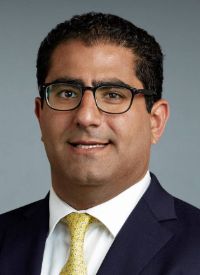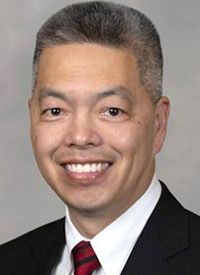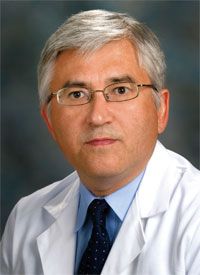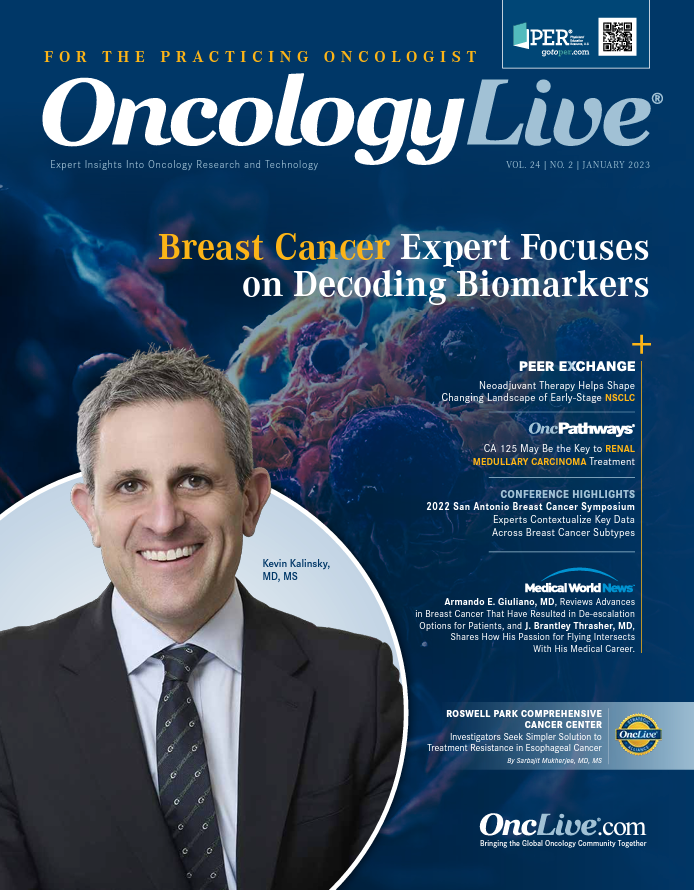Publication
Article
Neoadjuvant Therapy Helps Shape Changing Landscape of Early-Stage NSCLC
Author(s):
The treatment of patients with early-stage non–small cell lung cancer is rapidly evolving across the spectrum of care, particularly in the neoadjuvant setting, where evidence in favor of systemic chemoimmunotherapy regimens is growing.
Heather A. Wakelee, MD

The treatment of patients with early-stage non–small cell lung cancer (NSCLC) is rapidly evolving across the spectrum of care, particularly in the neoadjuvant setting, where evidence in favor of systemic chemoimmunotherapy regimens is growing, according to a panel of experts.
The sharpened focus on early-stage NSCLC, defined as stages I to III, comes after a decade of expanded therapeutic options in the advanced and metastatic disease settings. Investigators are hoping that improvements can be extended to earlier stages, where the opportunities for curative therapy are greater.1,2
Approximately 40% to 45% of patients diagnosed with lung cancer present with stages I to III disease, according to data from the National Cancer Institute’s Surveillance, Epidemiology, and End Results Program.1,3 The 5-year relative survival rates by stage show the comparatively better prognosis for patients with localized and regional disease vs those who are diagnosed with distant disease (Figure).3 Although surgery is a mainstay of treatment, recurrences are common, observed at a rate of more than 50% among patients with resected locally advanced (stage III) NSCLC.2
Figure. Lung Cancer Incidence and Survival by Stage

The developments for patients with early-stage disease include practice- changing data involving the use of sublobar resection vs lobectomy in certain patients with stage IA disease, testing of novel techniques in radiation oncology, and “aggressive neoadjuvant approaches” with systemic regimens, according to Heather A. Wakelee, MD, who served as moderator of a recent OncLive Peer Exchange® program. The panel of thoracic oncology experts discussed a broad range of topics affecting patients with stage I to IIIB NSCLC.
"There’s just so much happening,” Wakelee said. “I worked on adjuvant therapy for many years without moving the bar too far forward. It’s really exciting now that we have to think about early-stage lung cancer the way we’ve thought about metastatic disease.”
Potential for Less Invasive Surgery
Evidence is growing that limited resection is just as effective as a more invasive lobectomy for certain patients with operable stage IA NSCLC. In the phase 3 CALGB/Alliance 140503 trial (NCT00499330), investigators randomly assigned 697 patients to standard lobectomy (n = 357) or sublobar resection (n = 340) via segmentectomy or wedge resection. To be eligible, participants were required to have NSCLC clinically staged as T1aN0 with tumors 2 cm or smaller, node-negative disease at level 10, and up to 2 mediastinal stations.4,5
After a median follow-up of 7 years, sublobar resection demonstrated noninferiority to lobectomy, according to findings reported at the World Conference on Lung Cancer held by the International Association for the Study of Lung Cancer in August 2022.
The stratified HR for disease-free survival (DFS), the primary end point of the trial, was 1.01 (90% CI, 0.83-1.24; P = .0176 for noninferiority). The HR for overall survival (OS) was 0.95 (90% CI, 0.75-1.21; P = .014 for noninferiority). The 5-year DFS rates were 64.1% in the lobectomy arm and 63.6% in the sublobar group; the 5-year OS rates were 78.9% vs 80.3%, respectively.4
Jonathan Spicer, BSc (Hon), MD, PhD, FRCS.

The findings have generated a lot of discussion among surgeons, according to panel member and thoracic surgeon Jonathan Spicer, BSc (Hon), MD, PhD, FRCS. “A lot of [providers] had already migrated toward doing more sublobar resections, but these are massive efforts—they are decades-long efforts,” Spicer said.
However, he noted that “there are surgical implications, and probably long-term benefit implications, to what type of resection you do for which type of stage the patient has.” For example, patients with EGFR-mutant tumors of 2 cm might experience better outcomes by receiving osimertinib (Tagrisso) therapy for 1 or 2 months before surgery. Osimertinib, a kinase inhibitor, is approved as adjuvant therapy after tumor resection for patients with NSCLC whose tumors harbor EGFR exon 19 deletions or exon 21 L858R mutations.6
“If you can diagnose [the mutation] up front, if we’re going to give osimertinib for 3 years [as adjuvant therapy], then why don’t we start a month or 2 early? Then that patient can have a sublobar resection,” Spicer said. “That brings a lot of quality-of-life benefit and meaning to the patient’s experience of surgery.”
Joshua K. Sabari, MD

Joshua K. Sabari, MD, expressed concern that neoadjuvant osimertinib might make resection more difficult for general surgeons in community settings who would have less experience than their specialized peers in excising a more challenging “fibrosed EGFR tumor.”
There also might be a difference between sublobar resections carried out after oncologic staging and nodal sampling, which are “not the same as what have been referred to as wedge resections done by nonspecialist surgeons,” Billy W. Loo, Jr, MD, PhD, FASTRO, FACR, said.
Billy W. Loo, Jr, MD, PhD, FASTRO, FACR

Spicer agreed that more information is needed not only about the CALGB/ ALLIANCE findings but also about ongoing studies comparing surgery with stereotactic body radiation therapy (SBRT), which also is called stereotactic ablative radiotherapy (SABR).7 “We don’t know what the margins were between wedge vs segment [in the CALGB/ Alliance trial]. All these are really important issues, and we’ll have the trials of SBRT vs surgery that will inform things even more. You’re right, we have to be cautious and keep an open mind to what the possibilities are.”
Radiation Therapy Evolves
Although radiation therapy plays a significant role across stages in NSCLC,7 the panelists focused their discussion on the landscape in stage I disease. In the past several decades, Loo said, SABR “has become the standard of care for those patients who are not medically operable, or who have contraindications to surgeries. It’s become very well established in that cohort of patients, which is actually a fairly large proportion of patients with stage I disease, because this is generally an ill population with comorbidities.
“The question is whether fitter patients who could be surgical candidates would also be candidates for SABR,” Loo said. “It probably comes down to individualization. Surgical fitness is not a binary function. So perhaps patients who are elderly or who have different levels of frailty, particularly in light of the [CALGB/Alliance] data—perhaps a de-escalation, if you will—may still be effective. I think this opens that possibility a little more for potential indications for SABR.”
Overall, Loo said, the development of novel radiation therapy technologies is a “a rapidly evolving area.” He said interventional radiologists may prefer microwave or cryoablation to radiofrequency ablation. However, “in terms of local control, the thermal ablation techniques have not demonstrated as high a local control as SABR or surgery,” Loo said. “But I think there’s still going to be a role for that particularly, again, in certain subsets of patients where the minimum intervention—perhaps even doing a procedure at the time, [such as] a biopsy—may be in the best interest of the patient.”
Neoadjuvant Chemoimmunotherapy
The rationale for introducing neoadjuvant systemic therapy for patients with earlystage NSCLC includes expeditious treatment of micrometastatic disease and the potential for downstaging tumors to improve resection. However, there may be disadvantages, such as delays in local therapy and progression in patients resistant to a presurgical regimen.2 A continuing debate about whether patients should receive neoadjuvant therapy or adjuvant chemotherapy, which has become established for patients with early-stage NSCLC, is ongoing.1
Patients with IB to IIIA NSCLC should be evaluated for preoperative systemic therapy, where the options now include chemoimmunotherapy for patients eligible for immune checkpoint inhibitors (ICIs), along with chemotherapy doublets for those who are not candidates for ICIs, according to National Comprehensive Cancer Network (NCCN) guidelines.7 Specifically, neoadjuvant chemoimmunotherapy is the preferred recommendation for patients with stage IIIA disease without ALK or EGFR alterations.2
In March 2022, the combination of nivolumab (Opdivo), a PD-1–directed ICI, plus platinum-doublet chemotherapy became the first FDA-approved neoadjuvant regimen for early-stage NSCLC.8 The roster of late-stage clinical trials suggests additional ICI regimens will be available in the future, with pending phase 3 studies of combinations involving PD-1 inhibitor pembrolizumab (Keytruda) and PD-L1 inhibitors atezolizumab (Tecentriq) and durvalumab (Imfinzi; Table).2
Table. Ongoing Phase 3 Studies of Neoadjuvant ICIs in Resectable Early-Stage NSCLC

Meanwhile, the combination of durvalumab plus chemotherapy elicited a statistically significant improvement in pathological complete response (pCR) over chemotherapy alone among participants in a planned interim analysis of the phase 3 AEGEAN trial (NCT03800134), according to AstraZeneca, the company developing the therapy. The study recruited patients with resectable stage IIA to IIIB disease (tumors ≥ 4 cm or node positive). AstraZeneca said further details will be disclosed when event-free survival (EFS) data, a coprimary end point of the study, are available.9
Nivolumab Studies
The FDA based its approval of the neoadjuvant nivolumab combination on findings from the phase 3 CheckMate 816 trial (NCT02998528), in which 358 patients were randomly assigned 1:1 to receive nivolumab at 360 mg plus chemotherapy or chemotherapy alone every 3 weeks for up to 3 cycles followed by resection.8,10
Platinum-doublet therapy choices consisted of paclitaxel (175 mg/m2 or 200 mg/m2) plus carboplatin (area under the curve [AUC] 5 or 6) for any histology, pemetrexed (500 mg/m2) plus cisplatin (75 mg/m2) for nonsquamous tumors, and gemcitabine (1000 mg/m2 or 1250 mg/m2) plus cisplatin (75 mg/m2) for squamous disease.10
The primary end points were EFS and pCR, defined as 0% viable tumor in resected lung and lymph nodes, according to blinded independent review.
The trial recruited patients with stages IB (≥ 4 cm), II, or IIIA tumors without ALK or EGFR alterations and no grade 2 or greater peripheral neuropathy.10 Overall, 36.3% of patients in the nivolumab-containing arm had stage IB or II disease and 63.1% had stage IIIA; those cohorts comprised 34.6% and 64.2%, respectively, in the chemotherapy-alone arm.11
After a minimum follow-up of 21 months, the median EFS was 31.6 months (95% CI, 30.2–not reached) with the nivolumab-containing regimen compared with 20.8 months (95% CI, 14.0-26.7) with chemotherapy alone, favoring the addition of the ICI (HR, 0.63; 97.38% CI, 0.43-0.91; P = .005). The benefit was greater among patients with stage IIIA disease (HR, 0.54; 95% CI, 0.37-0.80) than it was for participants with stage IB or II disease (HR, 0.87; 95% CI, 0.48-1.56). Among all participants, the pCR was 24% (95% CI, 18.0-31.0) with the nivolumab regimen compared with 2.2% (95% CI, 0.6-5.6) with chemotherapy alone (OR, 13.94; 99% CI, 3.49-55.75; P < .001).11
The percentage of patients who had definitive surgery after neoadjuvant therapy was 83.2% in the nivolumab-containing arm and 75.4% in the chemotherapy-alone group. Surgery was canceled for 15.6% of patients in the nivolumab group and 20.7% in the chemotherapy-alone group, most frequently because of disease progression (6.7% vs 9.5%, respectively) or other reasons (7.8% vs 10.6%, respectively), including patient refusal, unresectability, and poor lung function. Median OS, a key secondary end point, was not reached in either arm.11
In terms of toxicities, the incidence of grade 3 or 4 treatment-related adverse events was 33.5% with the nivolumab-containing regimen and 36.9% with chemotherapy alone, most frequently neutropenia and decreased neutrophil count in both arms.11
The addition of nivolumab to chemotherapy resulted in superior median EFS vs chemotherapy alone among patients with lymph node (LN) involvement (HR, 0.69; 95% CI, 0.42-1.13) and in participants without LN involvement (HR, 0.74; 95% CI, 0.39-1.41), according to findings from a post hoc analysis of CheckMate 816 data presented during the European Society for Medical Oncology Congress 2022 in September.12
Additionally, patients with LN involvement who received the nivolumab regimen and whose pathological response reached 0% of residual viable tumor (RVT) in both the primary tumor and LN seemed to achieve the longest EFS compared with those who had 0% RVT in either setting or with greater than 0% RVT in both. Similarly, patients achieved a higher percentage of regression with the nivolumab combination vs chemotherapy alone.12
Further data supporting the use of nivolumab in the neoadjuvant setting was reported from the phase 2 NADIM II trial (NCT03838159) in patients with resectable clinical stage IIIA to IIIB disease and no known ALK or EGFR alterations. Participants were randomly assigned 2:1 to receive nivolumab at 360 mg plus paclitaxel (200 mg/m2) and carboplatin (AUC 5) for 3 cycles every 21 days or the same chemotherapy doublet alone as neoadjuvant treatment followed by surgery. Patients with R0 resection then received adjuvant nivolumab at 480 mg every 4 weeks after surgery for 6 months, whereas those in the control arm underwent observation.13
At 24 months, progression-free survival (PFS) was 66.6% for patients who received the nivolumab regimen (n = 57) compared with 42.3% among participants treated with chemotherapy alone (n = 29), which translated into an HR favoring nivolumab of 0.48 (95% CI, 0.25-0.91; P = .025). OS was 84.7% with nivolumab vs 63.4% with chemotherapy alone (HR, 0.40; 95% CI, 0.17-0.93; P = .034). PD-L1 expression levels of 1% or higher correlated with improved PFS (HR, 0.26; 95% CI, 0.08-0.77; P = .015).13
Choosing Patients for Therapy
The prospect of improving therapy with systemic neoadjuvant treatment is gaining traction among surgeons. “Surgeons are stating that we’re not curing patients at high rates with stage II or greater disease—even stage IB,” Sabari said. “It’s our preference at our institution to do the CheckMate 816 regimen.
“If we can offer a patient a systemic therapy that helps guide their outcome postoperatively, then it’s a window of opportunity as well,” he said. “It’s a no-brainer to me. When you talk to patients about that in the clinic, most patients do opt for a neoadjuvant approach.”
Patients with stage III disease, which carries a high risk of recurrence, should clearly be candidates for systemic neoadjuvant therapy, Sabari said. Patients with stage II disease also should be considered, he added. “It’s the IB/IIA’s that become controversial in tumor board,” he said. “I think that’s going to be an ongoing discussion until we see real survival benefit that’s long term.”
Loo sounded a note of caution about embracing neoadjuvant approaches too quickly. In an answer to a question about patients with stage IIIB NSCLC, he said he was concerned about “trying to expand the indications [to] patients who would not have been considered resectable up front, and the idea is that now we’re going to try and make them resectable with induction therapy. That’s a risky extrapolation.”
Molecular Testing Patterns Shift
The potential for neoadjuvant regimens also is moving molecular testing earlier in the treatment timeline. NCCN guidelines call for testing all patients with advanced or metastatic disease for alterations in 9 key genes plus PD-L1 expression.
In earlier stages, it is helpful to know the status for EGFR and ALK alterations and PD-L1 expression, particularly for any tumor over 4 cm or with positive LNs, Spicer said. There also are indications that mutations in the KEAP1/NFE2L2 pathway may play a role in local recurrences after radiation therapy, Loo said.
Ignacio I. Wistuba, MD

Although the trend has been to use large panel tests for gene analyses, the need for such information at an earlier time point is changing the outlook. “We are revamping our smaller panels that can provide an answer in less than 2 weeks because there is this need to have an answer quickly for patients who are going to have a potentially curative procedure,” said Ignacio I. Wistuba, MD, a pathology expert.
“It’s an interesting phenomenon.” Wistuba stressed that obtaining appropriate tissue specimens for biomarker testing in early-stage disease is crucial. He believes liquid biopsy assays have a role in the diagnosis of lung cancer and in advanced metastatic disease but not in earlystage diagnostics.
“The concern by bringing this technology or methodology to a patient with early disease is that cell tumor DNA free in the blood is based on tumor burden in patients,” Wistuba said. “We’re talking about small lesions. We don’t know whether there’s going to be enough cell tumor DNA in the blood to be detected by molecular tests that are not so sensitive. I will be cautious [about] extrapolating [from] the metastatic setting to early disease because the sensitivity of those tests in that particular population may not be up to what we need to do a proper diagnosis.”
Wistuba said it is vital for thoracic oncology specialists to communicate with pulmonary doctors who frequently are the first physicians to see patients with lung cancer. “The important point in that area now is to engage the pulmonary doctors so we can have enough of a good specimen for a good histology diagnosis and molecular testing,” he said. “I used to say [we needed] only core biopsies. Now that we’re facing this reality, I need a good sample, a good biopsy. It could be [fine needle aspiration], cytology, or tissue, because I think that can be done.”










